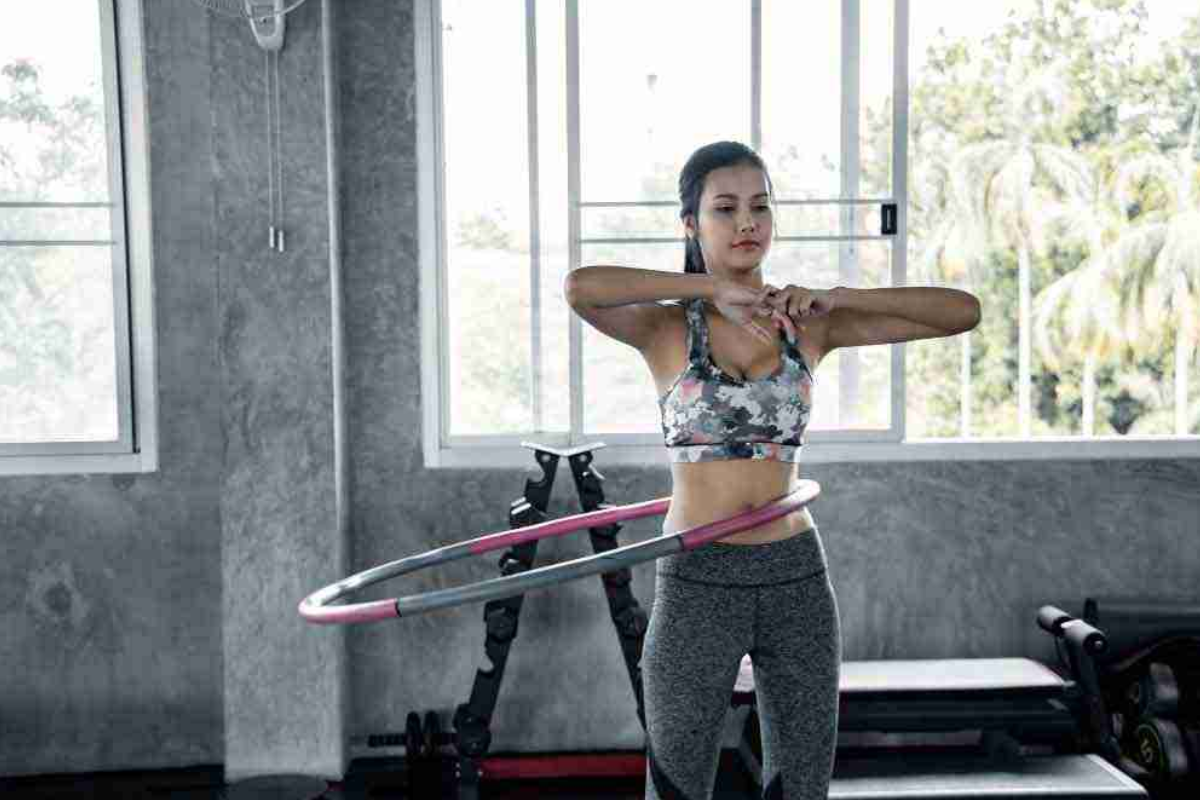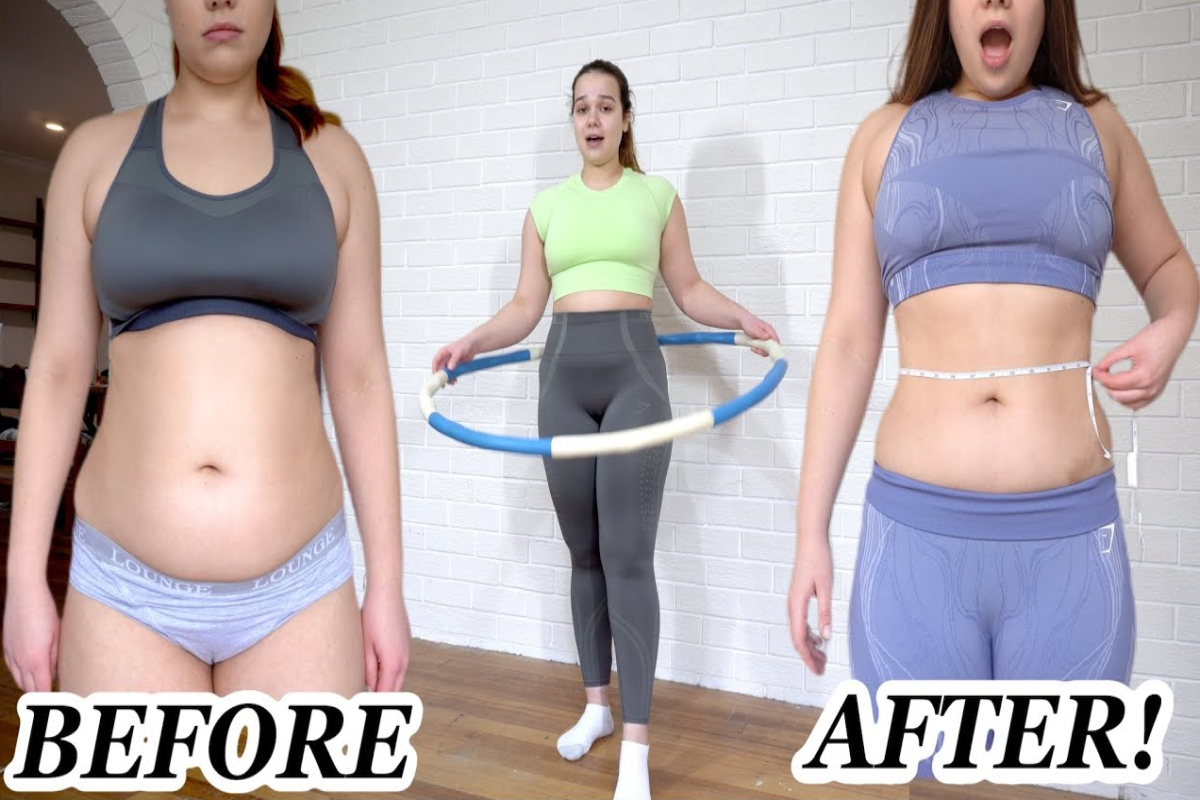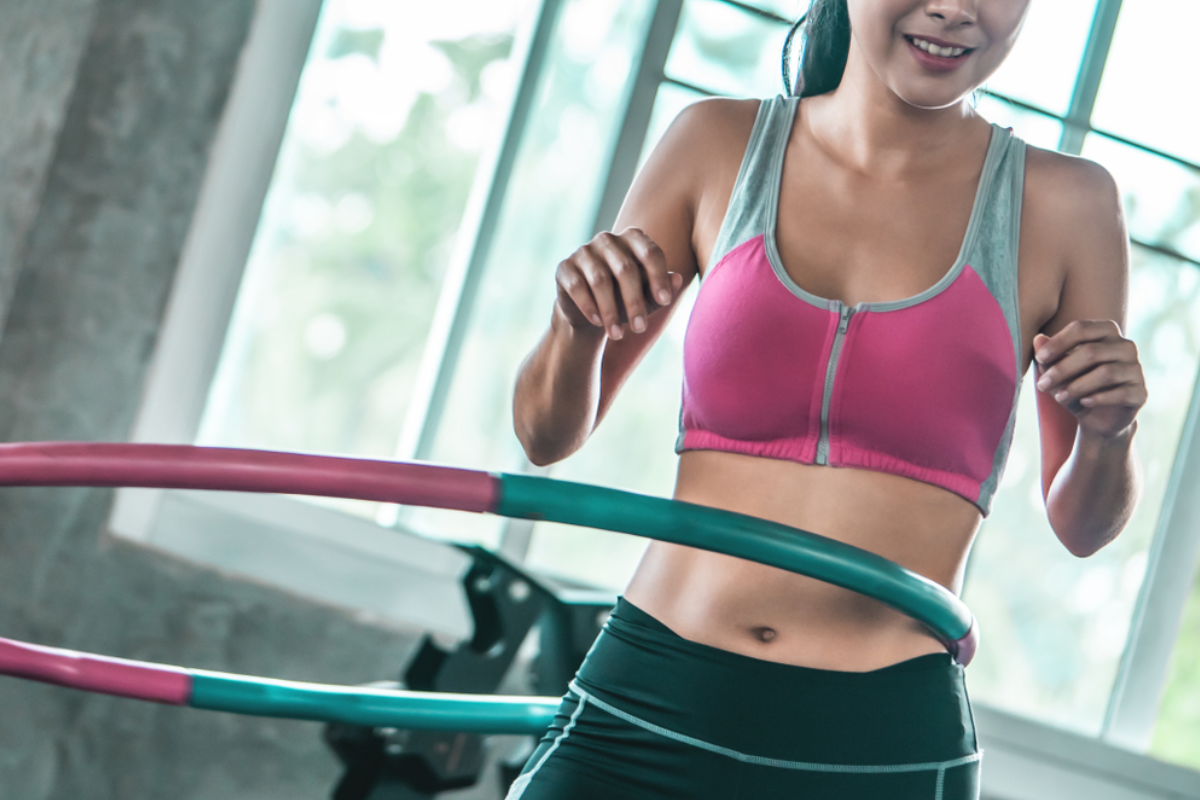Hula hooping or hula hoops is usually regarded as an entertaining activity but has captured the attention of some individuals in the wellness community because of its weight loss and fitness benefits. This article aims to investigate Hula hoop weight loss and its effects, such as cardiovascular conditioning, muscle activity, and energy expenditure. How one go about recommending, advocating and having some personal experiences of how a hula hoop can aid weight loss will be covered in some scientific findings and studies and individuals who are professionals in this field? Besides, readers will also find helpful information on how often and how well to provide maximum efficiency in conclusion, which will give them adequate information on how to fast-track the incorporation of this interesting activity in their fitness routines.
What is a Hula Hoop?
How Does a Hula Hoop Work?
Hula hooping engages basic physics principles with a center of mass on rotational motion and torque. When the performer encircles their waist with the hoop, they invoke a force that zags that hoop round along a circle. The ring-shaped movement is aided by the complementary hip circumvolution, which involves a bobbing style. The strength of contraction of the deep abdominal and oblique muscles that also stabilizes the torso region allows for retention of the hula hoop’s rotation. There are also involuntary motions whereby as the performer thrusts their body towards the hula hoop suspended in air, several other muscles, such as the back and legs, are exercised in addition to those of the upper body. The rhythmic motion further increases heart rate, enhancing cardiovascular benefits while improving movement requirements and equilibrium.
Hula Hoops – Their Varieties
Hula hoops come in different types and are meant for different reasons and skills levels of the people using them. The major types of these hula hoops include:
- Beginner Hoops: These hoops are the first ones for some users, so I recommend they be made larger and made of heavier materials. Since they rotate slowly, it is easier to learn and master the basics. The weight also enhances balance and makes it more controlled.
- Fitness Hoops: These are made to enhance exercise and are, therefore, wider and heavier than ordinary hoops. They also facilitate greater resistance, which makes it possible to burn more calories and target each of the muscle groups more effectively. Many of them use pregnancy-sound features to facilitate such usage.
- Dance Hoops: These hoops are performed on aerial dancers. Because they are designed for speed, they are generally lighter and often smaller. These hoops allow for greater movement and a wider range of motion. They thus can perform advanced moves and artistic creation to the advantage of both the performer and the phenomenon enthusiast dancer.
Learning and knowing the various hula hoops makes it easy for individuals to choose the one that suits their exercises, thus enhancing the fun and effectiveness of the fitness crusade.
Benefits of Using a Hula Hoop
A hula hoop for exercising helps in improving fitness levels and burns calories among other things, which can be measured within specific technical parameters:
- Caloric Expenditure: This paper notes that hula hooping can burn 200-600 calories in an hour, depending on the individual’s weight, the type of hula hoop, and the degree of intensity of the activity. Such a considerable rate of calorie consumption proves beneficial to people seeking to manage their weight and lose fat.
- Core Strength Development: Most of the muscles involved in hula hooping’s movements are the core muscles, such as the abdominal, oblique, and lower back region. This activity can help increase core stability and strength, with some studies indicating an increase in core muscle activation of up to 30% when the hoop is used for a long duration.
- Improved Coordination and Balance: Adequate and regular hula hoop practice helps not only improve the degree of coordination within the body segments and proprioception – the perception of the position of the limbs and body in space. The active hula-hooping phase requires the user to constantly change position backward, forward, tilt sideways and rotate making motor development inevitable.
- Increased Flexibility and Range of Motion: Hula hoop activities require a reasonable degree of hip, waist, and shoulder movement over a period of time, which can improve these body parts’ motions. This benefit can lower the chances of injury and improve one’s ability to perform other sports.
- Mental Well-Being: Hula hooping often has a calming and repetitive quality, which can help calm the mind and alleviate stress. Participating in such a fun form of exercise helps release more natural body measures, uplifting the mood and overall wellness of the psyche.
With such integration of hula hooping within the weekly fitness routine of individuals, it can be seen that these not only help build fitness but also gain notable benefits in mind and emotion, leading to total health.
How Do You Use a Hula Hoop for Exercise?

Hula Hooping for Beginners
Choose the Right Hoop, and wider and Heavier Hoops Are Best Suited For Beginners. This is important as it helps the beginner better control the hoop. The diameter of the hoop should be such that it lies between the waist and chest for better and effortless use.
- Begin with Soft Surface: Start practicing on a soft surface like grass or a gym mat. This will help with comfort and also provide some level of safety in case of a loss of control of the hoop.
- Maintain Right Stance: Athletes should stand on the bases with shoulders square to the grid and feet almost shoulder-width apart. This basic stance will help them maintain a well-centered stance, which is vital in affecting the movement of the hoop.
- Consecrate on Bowels Movement: Accurate movement is described as the sideways action of the hips. Draw the hoop in with a gentle thrust of the core, which has a sweeping whirl about it.
- Practice Timing: When the hoop goes down, the body slightly leans back, but the hips are pushed forward to prevent the hoop from crashing down. Timing the body movement with the rotation of the hoop is essential in sustaining the carry and hope of the hoop.
- Keep Your Hands in the Same Position: Don’t go out of arms movement. Just keep your hands to your body. This will enhance stillness thus preventing unnecessary movement of the arms and improving the degree of abdomen contraction.
- Remain Steadfast and Constant: It can be observed that mastery of hula hooping is not instant since it requires one to endure and practice at all times. Be patient, and increase the duration of practice slowly and steadily as the confidence rises.
These tips can also help students begin with some fundamental areas of hula hoop and enjoy making the workouts a part of everyday life.
Making a Hula Hoop Workout Plan
It is fundamental to apply the right principles in carrying out any hula hoop workout plan. One must ensure that the plan addresses cardiovascular needs, strength, and flexibility without making the workout boring and useless.
- Warm-Up (5-10 Minutes): Commence with a mild warm-up to get your body ready. I recommend arm circles, torso twists, and leg swings to warm up and increase blood circulation.
- Interval Hooping (15-20 Minutes): One should include intervals in which activity consists of hula hooping moderate for 1-2 minutes followed by 30 seconds a hula hooping which one does fast or does other activities like hula hooping and squats, lateral shuffle etc.
- Strength Exercises (10-15 Minutes): Begin strength movements while the hoop is still moving. Do squats, lunges, and plank holds, then do them again, this time focusing on the core muscles to maintain correct posture.
- Cool Down (5-10 Minutes): The session could end with static stretches emphasizing hip flexor, shoulder, and lower back muscles to develop their flexibility and assist in recovery.
- Frequency: Target practicing the routine 3-4 times within a week, improving the frequency, duration, and intensity level due to improvement in fitness and skill. Further on, as you might want to change it up a bit, add some various hooping styles or tricks.
By incorporating these aspects into your hula hooping routine, you will improve your fitness levels and increase your fun using this effective instrument.
Mistakes you Should Not Make Using a Hula Hoop
There are various kinds of hula hooping that can be learned. However, many hooper errors can negatively affect your performance and devalue the workout.
- Poor Body Position: Good posture is important to safeguard the body and attain the desired results. Poor posture, such as a lack of a straight back and engaged core, affects the efficiency of hooping and poses a strain. Position the shape of the spine and an evenly tipped pelvis for movement to be of better form.
- Bearing Wrong Sized Hoops: Insufficient hoop size or light hooping elements lengthen the learning process and discourage the novice. Proper hoop size should be targeted. It should extend to the waist when the hoop is stood on the ground. To further bask in typical modern hooping, use heavier hoops.
- Focusing on Other Body Parts: Most beginners fail to realize the need to engage the core. The stomach muscles are indeed the crucial muscles that support this action. The core muscle must be active during the entire hula hoop routine to control the hula hoop better and thus achieve a better outcome.
Mistakes of this kind can be avoided by the individual, which will improve his/her ability to use a hula hoop to its full potential.
What Are the Fitness Benefits of a Hula Hoop?

Health Benefits of Cardio in Hula Hoop Workouts
The activity of hula hooping increases the heart rate, thereby increasing cardiovascular endurance. The heart and smooth muscles of the body become accustomed to the physical activity as they include hoop turning on a particular line for a prolonged time. On this note, it is worth mentioning that polysynaptic reflexes activate energetic expenditure up to the level that exercising a hula hoop can spend an amount of energy quite similar to that of running or cycling. Also, moving using a hoop increases blood and oxygen throughout the body and is capable of doing any physical activity for a long period. Getting used to the above considerations and integrating hula hooping into your training will be the best way of enjoying and achieving a cardio workout.
Hula Hoops And Its Impact on The Caloric Expenditure
A good amount of calories are burnt through the use of hula hoops due to the combination of movement and muscle activity. One’s core is also engaged through shifting the hoop around the waist. This is vital in expending energy because of working the abdominal, lower back, and oblique muscles. Further, as the users lift and round their hips and twist their feet as a way to keep the hoop moving, the arm muscles and the butt muscles will be put to use in addition, and more calories will be burnt. However, on average, hula hooping sees one burning around 200 to 600 calories in an hour, depending on the level of intensity, physical fitness, and body composition. In summary, since hula hooping combines aerobic and involuntary muscle work, which involves moving the hoop inside, this exercise is extremely effective for calorie burning and weight control.
Effect on Sitting Core and Fat Reduction
Hula hooping improves core strength much due to the continuous activation of the abdominal muscles that is needed to keep the hoop spinning. Not only does the resultant core activation strengthen it, but it also helps in improving overall balance and stability. If a person hula hoops regularly over a few months, it is possible for them to notice a reduction in abdominal fat, mainly because of excessive calorie burn during such sessions. With the increased exercise and specific muscular activity, practitioners are able to shed the excess body fats quickly while gaining a firmer middle. Having core strength helps in improving sports performance, functional tasks, and everyday activities because hula hooping becomes one of the gears of the holistic workout system.
Are There Any Drawbacks to Using a Hula Hoop?

Possible Risk Factors and Their Prevention
Even though hula hooping is a low-intensity fat-burning workout, injuries can also be encountered if the rules dictated are not followed. The most common of such injuries include hip or abdominal bruises, muscle tension, and even varying degrees of discomfort in the lumbar region resulting from poor postural practices or using excessive force during workouts such as hula hooping, although this is rare. One risk can be avoided by selecting a hoop that fits the individual’s height and level of fitness. They should likewise be using an appropriate surface, for instance, they should avoid hard or uneven surfaces since such enhances chances of getting injured.
Before any activity begins, it is essential to warm up while cool down must be done after about the bodily mechanisms involved. Gradatively increasing the level or duration of each session over time may also condition the body so that there are no incidents of overuse. Lastly, good techniques and tummy tuck throughout the activity will improve efficiency and prevent injuries for hula hooping will be an efficient and safe way of exercising if done carefully and sensibly.
Customer Feedback and Recurring Issues
A review of customers on hula hooping reveals it to be an exciting endeavor with numerous health benefits. Most users indicate that they have improved, especially in the core, flexibility, and fitness, and are pleased with the fact that this exercise has been incorporated into their routines. Some of the reviews talked about the challenges of controlling the hoop, especially for the novices since the frustration could be very high. Others indicate that some of them could not lose weight as quickly as they had hoped, reinforcing that hula hooping has to be complemented with other exercises, as well as good nutrition. Also, there are accounts of pain in some cases after long practice sessions, often blamed on inappropriate selection of the hula hoop which is either too heavy or too light for the individual’s level of expertise. These issues usually mean that the customers will need to be trained on how to choose the right hoop size, learn the right techniques, and do not have exaggerated expectations regarding their fitness levels.
Evaluating How Fitness Hoops Differ from Classic Hoops
Comparing fitness hoops and traditional hoops used in play, one can observe some technical aspects that highlight their differences in functional use and design features. To begin with, fitness hoops are made of bulky and large hoops, which can effectively use the body’s muscles, especially the core. The weight of the hoops also creates a wider terminator, making it easier to use extra energy to create motion, helping in heart and muscle exercises. On the other hand, regular hoops are made of lightweight plastic materials designed for use in fun activities like games and dances, which requires speed and quickness instead of strength.
In addition, fitness hoops are also made more convenient through the inclusion of ‘smart’ elements such as saddle or weight change mechanisms. The surface of the fitness hoop is made to enhance balance and control thus assisting beginners in learning the skill while reducing chances of injury. On the other hand, a normal traditional hoop emphasizes length and maneuverability without the ergonomic and functional designs of fitness hoops. Nevertheless, all these aspects need to be stressed to consumers who intend to buy hoops depending on their hobbies or fitness goals.
What to Look for When Buying a Hula Hoop?

Features to Consider: Smart Hoops and More
What are the key factors when looking for a hula hoop? This is critical, especially in fitness hula hoops, to make sure that all factors are positively enhancing performance and usability. Some of the smart hoops come with technology that serves the purpose of tracking workout metrics, including calories burned, time taken, and amount of rotations, and gives instant feedback on ways in which user training can be made better. Most of the time, these hoops are composed of smart technologies that can be installed on phones to assist the user in keeping track of all achievements reached after a certain period of time and planning realistic fitness targets.
Other factors relate to how the hoop is made, its weight, and its circumference. A hoop with strong and flexible materials will be safe from many problems and will also be easily used by the users. This holds true for the weight of the hoop as well, which in terms of the dynamic range of motions of a user’s body, determines the type of resistance given by the hoop in workouts – the heavier, the more resistance, thereby greater activation of the core. Finally, the size of the hoop matters when it comes to user experience. A large enough hoop is more likely to be manageable and easier to use than a small one whose “ideal” size would be roughly determined by its owner’s height or fitness level. It becomes essential to consider such features to enable the users of hula hoops to get the ones that fit perfectly within their fitness goals.
Highly Crucial Review of Hula Hoops as Per Customers’ Feedback
In relation to hula hoops, customer feedback often draws attention to quite a few leading hula hoop brands in terms of their performance, durability, and satisfaction. Proform Smart Hula Hoop is one of them since it contains fitness tracking technology and adjustable weight options. Since it is too strong, customers claim that it retails quickly with companion apps that help to collect performance data.
ALEX Hula Fitness Hoop, another alternative hula hoop, has also received laud for its ergonomic design, which is simple and quick to use for novices and experts. The lightweight design and comfortable handle make it possible to use for extended periods. There are also positive user reviews regarding the hoop since it assists in strengthening the core muscles and improving coordination skills.
Last but not least, the Everlast Weighted Hula Hoop is primarily focused on the audience and incorporates aerobic activity with the use of weights. Reviewers have praised it for its great strength of construction and the intense effort required of one’s body to keep working out with it, effectively using the abdominal muscles.
Looking at all these user reviews and experiences, it is evident that any potential customer can choose the right hula hoop accordingly.
Cost and Quality Comparison
When determining the price range of hula hoops, it is prudent to appreciate the price-quality relationship before purchasing them. Low-priced models are generally within a price range of 10 to 30 dollars, with basic design and materials aimed at the casual user or novice. Moderate hula hoops range from $30 to $70 and come with several features like weighted, sturdier, and more user-friendly designs to enhance the workout experience and the workout itself.
High-end hula hoops, ranging from $70 to $150 and sometimes more, have advanced technology and materials. These designs offer additional functional options, such as a fitness tracker and micro-weight adjustment. This category suits serious patients who need all means at their disposal for intensive training to achieve improved performance. Finally, a detailed analysis and comparison of the cost versus the quality show that paying more for a quality hula hoop will be worth it since it will last longer and help attain better results while exercising.
Success Stories and Related Stories

Utilizing Hula Hoops – Some Real Life Examples
There are many examples in the literature of how people have successfully incorporated hula hoops in their fitness routines. For example, one user mentions that after three months of hula hooping, they reduced their waist size considerably and credited it to the core muscle involvement and enhanced cardiovascular fitness. Another person reported feeling more steady and coordinated after a hooping exercise to the point that this rhythmic action transfers over to coordination in other activities, including dancing and team games. Also, several friends reported using hula hooping as a group fitness activity, indicating that it was more fun and actually made people want to exercise, encouraging a better outcome in terms of fitness. These examples particularly demonstrate the multi-faceted nature of hula hoops in delivering a workout as a helpful fitness tool and creating bonds among fitness enthusiasts.
Objectives of Fitness Accomplished Via Hula Hoop Workouts
Due to the super ability of the tool to involve many muscles simultaneously, hula hoop workouts stand out as a very effective method of satisfying various fitness needs. Most of the study participants reported an increase in core stability due to the strengthening of the abdominal region and improvements in the muscle tone. Besides, hula hoop exercises also give a good cardio workout since subjects have been reported to burn between 400 and 600 calories in an average hour, depending on the individual effort. This caloric burning influence helps control weight and weight loss. In addition, the circular motion and the torso undulation accompanying the hooping movements will improve cardiovascular endurance and ability. Lastly, and most importantly probably, many users report to have benefits in that flexibility and coordination improve through repeated movement of regular sections of the body which is why the users hold the solid rim more often for many reasons, making hula hoops the most versatile fitness tool for enhancement in many aspects.
Frequently Asked Questions (FAQs)
Q: What is the significance of hula hoop in cutting weight?
A: Weight loss is possible when hula hoops are used, especially because they provide cardiovascular exercise that helps shed calories and fat. The added weight raises the level of the workout, and it helps strengthen the core, waist, and hips. Doing this regularly can make a significant difference after some time.
Q: How much time should I spend using a hula hoop to attain results?
A: To achieve satisfactory results, it is advisable to use a hula hoop for a minimum of 10 to 30 minutes per day, multiple times a week. This period, however, could change and depend on the individual’s desires and level of fitness. It is strongly recommended that one use the hula hoop on a regular basis if they want to lose weight or tone up.
Q: Are there any restrictions in using hula hoops or can everyone do it no matter how fit they are?
A: Hula hoops are appropriate for a wide spectrum of users depending on their level of physical fitness. A hula hoop for beginners would be of lower weight, and then the weight would increase as their fitness gets better. Nevertheless, anyone with any back or hip complaints should get permission first.
Q: Are there different types of weighted hula hoops available?
A: Yes, there is a range of weighted hula hoops available, including smart weighted hula hoops and fitness hula hoops. Some even come with a weighted ball and other features that allow them to be assembled and disassembled easily for transport and storage.
Q: What is a smart weighted hula hoop?
A: A smart weight hula hoop can best be described as an improved hula hoop with weight-stabilizing features. It usually boasts a rotating counter that can keep track of the number of spins and calories burned, amongst other selling points. It even has a removable part. Such features increase progress in workouts and motivation.
Q: How do I choose the right weighted hula hoop for me?
A: As such, when using a weighted hula hoop, you have to pay attention to factors like weight, diameter, and material used. Beginners may opt for a beginner hoop as it is generally paperweight; advanced users can then use the ultimate one, which is bulky and challenging. Make sure that the hoop can be used comfortably after just a few tries and also fulfills your fitness target ambition.
Q: What are the advantages of weighted hula hoops over other fitness accessories?
A: There are several benefits to using a weighted hula hoop that extend beyond the mere immunity of heart disease. These benefits include toning the core muscles, improving body flexibility, and much more. It is also enjoyable, which makes it ideal for workout routines as the right motivation may be acquired. Furthermore, it is light and takes up little space, hence making it ideal for working out at home.
Q: May I engage a hula hoop of weights that I have in my workout at this time?
A: Certainly, there are means by which a weighted hula hoop can be added to the current exercise regimen. It serves as an excellent warm-up, or an equally excellent cool-down and also as an exercise that one may wish to focus on. To get the full benefits of the workout including improvement in fitness and weight loss, one can also combine it with other workouts such as strength exercises or cardio.
Q: Should I take any measures while using a weighted hula hoop and which ones?
A: When using a weighted hula hoop, first-timers must be cautious and try everything at a steady pace to avoid straining the muscles and, in turn, injuring themselves. Stretch your muscles well before and after Miat flows. Stop your activity immediately and consult the doctor if you develop any pain. Most importantly, you should ensure that there are no people or hard objects that you might bump into while hooping.
Related Posts :
- En Pro Keto Acv Gummies Exclusive Report The Dark Side Of Pro Keto Acv Gummies Revealed Jmvb
- En Keto Fusion Sugar Free Gummies The Best Weight Loss Gummies Keto Fusion Sugar Free Gummies Vs Nurish By Nature Made Daily Wellness Gummies L2dz
- En Keto Gummies Review 2 Iq6o
- En 30 Day Menopause Weight Loss P99z
- En Ethan Suplee Weight Loss Guide Autumn Tips From Celebrities To Shed Pounds Cs9b